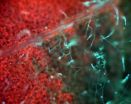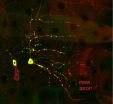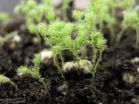(Press-News.org) New research reveals that the abundance of so-called highly siderophile, or metal-loving, elements like gold and platinum found in the mantles of Earth, the Moon and Mars were delivered by massive impactors during the final phase of planet formation over 4.5 billion years ago. The predicted sizes of the projectiles, which hit within tens of millions of years of the giant impact that produced our Moon, are consistent with current planet formation models as well as physical evidence such as the size distributions of asteroids and ancient Martian impact scars. They predict that the largest of the late impactors on Earth, at 1,500-2,000 miles in diameter, potentially modified Earth's obliquity by approximately 10 degrees, while those for the Moon, at approximately 150-200 miles, may have delivered water to its mantle.
The team that conducted this study comprises solar system dynamicists, such as Dr. William Bottke and Dr. David Nesvorny from the Southwest Research Institute, and geophysical-geochemical modelers, such as Prof. Richard J. Walker from the University of Maryland, Prof. James Day from the University of Maryland and Scripps Institution of Oceanography, and Prof. Linda Elkins-Tanton, from the Massachusetts Institute of Technology. Together, they represent three teams within the NASA Lunar Science Institute (NLSI).
A fundamental problem in planetary science is to determine how Earth, the Moon, and other inner solar system planets formed and evolved. This is a difficult question to answer given that billions of years of history have steadily erased evidence for these early events. Despite this, critical clues can still be found to help determine what happened, provided one knows where to look.
For instance, careful study of lunar samples brought back by the Apollo astronauts, combined with numerical modeling work, indicates that the Moon formed as a result of a collision between a Mars-sized body and the early Earth about 4.5 billion years ago. While the idea that the Earth-Moon system owes its existence to a single, random event was initially viewed as radical, it is now believed that such large impacts were commonplace during the end stages of planet formation. The giant impact is believed to have led to a final phase of core formation and global magma oceans on both the Earth and Moon.
For the giant impact hypothesis to be correct, one might expect samples from the Earth and Moon's mantle, brought to the surface by volcanic activity, to back it up. In particular, scientists have examined the abundance in these rocks of so-called highly siderophile, or metal-loving, elements: Re, Os, Ir, Ru, Pt, Rh, Pd, Au. These elements should have followed the iron and other metals to the core in the aftermath of the Moon-forming event, leaving the rocky crusts and mantles of these bodies void of these elements. Accordingly, their near-absence from mantle rocks should provide a key test of the giant impact model.
However, as described by team member Walker, "The big problem for the modelers is that these metals are not missing at all, but instead are modestly plentiful." Team member Day adds, "This is a good thing for anyone who likes their gold wedding rings or the cleaner air provided by the palladium in their car's catalytic convertors."
A proposed solution to this conundrum is that highly siderophile elements were indeed stripped from the mantle by the effects of the giant impact, but were then partially replenished by later impacts from the original building blocks of the planets, called planetesimals. This is not a surprise — planet formation models predict such late impacts — but their nature, numbers, and most especially size of the accreting bodies are unknown. Presumably, they could have represented the accretion of many small bodies or a few large events. To match observations, the late-arriving planetesimals need to deliver 0.5 percent of the Earth's mass to Earth's mantle, equivalent to one-third of the mass of the Moon, and about 1,200 times less mass to the Moon's mantle.
Using numerical models, the team showed that they could reproduce these amounts if the late accretion population was dominated by massive projectiles. Their results indicate the largest Earth impactor was 1,500-2,000 miles in diameter, roughly the size of Pluto, while those hitting the Moon were only 150-200 miles across. Lead author Bottke says, "These impactors are thought to be large enough to produce the observed enrichments in highly siderophile elements, but not so large that their fragmented cores joined with the planet's core. They probably represent the largest objects to hit those worlds since the giant impact that formed our Moon."
Intriguingly, the predicted distribution of projectile sizes, where most of the mass of the population is found among the largest objects, is consistent with other evidence.
New models describing how planetesimals form and evolve suggest the biggest ones efficiently gobble up the smaller ones and run away in terms of size, leaving behind a population of enormous objects largely resistant to collisional erosion.
The last surviving planetesimal populations in the inner solar system are the asteroids. In the inner asteroid belt, the asteroids Ceres, Pallas and Vesta, at 600, 300 and 300 miles across, respectively, dwarf the next largest asteroids at 150 miles across. No asteroids with "in-between" sizes are observed in this region.
The sizes of the oldest and largest craters on Mars, many of which are thousands of miles across, are consistent with it being bombarded by an inner asteroid belt-like population dominated by large bodies early in its history.
These results make it possible to make some interesting predictions about the evolution of the Earth, Mars and the Moon. For example:
The largest projectiles that struck Earth were capable of modifying its spin axis, on average, by approximately 10 degrees.
The largest impactor to strike Mars, according to this work and the abundance of highly siderophile elements found in Martian meteorites, was 900,100 miles across. This is approximately the projectile size needed to create the proposed Borealis basin that may have produced Mars' global hemispheric dichotomy.
For the Moon, the projectiles would have been large enough to have created the South-Pole-Aitkin basin or perhaps a comparable-sized early basin. Moreover, if they contained even a trace amount of volatiles, then the same processes that brought highly siderophile elements to the Moon's mantle may have also delivered its observed abundance of water.
INFORMATION:
The article, "Stochastic Late Accretion to the Earth, Moon, and Mars" will be published in the Dec. 10 issue of Science.
END
Norwich scientists are on the trail of some of the most economically damaging organisms that infect crops worldwide. Their latest targets are the parasitic water fungus that causes powdery mildew and the water molds that cause late blight in potatoes and tomatoes and downy mildew in cruciferous vegetables and other crops.
"We have been studying the late blight pathogen for a while," said Professor Sophien Kamoun, head of the Sainsbury Laboratory on the Norwich Research Park. "In separate research we are trialling plant genes that mediate blight resistance, while in this ...
A team of scientists led by Melissa Rolls, an assistant professor of biochemistry and molecular biology at Penn State University, has peered inside neurons to discover an unexpected process that is required for regeneration after severe neuron injury. The process was discovered during Rolls's studies aimed at deciphering the inner workings of dendrites -- the part of the neuron that receives information from other cells and from the outside world. The research will be published in the print edition of the scientific journal Current Biology on 21 December 2010.
"We already ...
PITTSBURGH—If you're looking to lose weight, it's okay to think about eating your favorite candy bar. In fact, go ahead and imagine devouring every last bite — all in the name of your diet.
A new study by researchers at Carnegie Mellon University, published in Science, shows that when you imagine eating a certain food, it reduces your actual consumption of that food. This landmark discovery changes the decades-old assumption that thinking about something desirable increases cravings for it and its consumption.
Drawing on research that shows that perception and mental ...
An international team of scientists, which includes researchers from Virginia Tech, has cracked the genetic code of a plant pathogen that causes downy mildew disease. Downy mildews are a widespread class of destructive diseases that cause major losses to crops as diverse as maize, grapes, and lettuce. The paper describing the genome sequence of the downy mildew pathogen Hyaloperonospora arabidopsidis, which attacks the widely studied model plant Arabidopsis thaliana, is the cover story of this week's edition of the journal Science.
In the paper, the sequence of H. arabidopsidis ...
Doctors often ask kidney disease patients on dialysis to limit the amount of phosphate they consume in their diets, but this does not help prolong their lives, according to a study appearing in an upcoming issue of the Clinical Journal of the American Society Nephrology (CJASN). The results even suggest that prescribing low phosphate diets may increase dialysis patients' risk of premature death.
Blood phosphate levels are often high in patients with kidney disease, and dialysis treatments cannot effectively remove all of the dietary phosphate that a person normally consumes. ...
Researchers have long known that the devastating disease called Duchenne muscular dystrophy (DMD) is caused by a single mutation in a gene called dystrophin. The protein encoded by that gene is critical for the integrity of muscle; without it, they are easily damaged. But new findings in mice reported online in the journal Cell on December 9th by researchers at Stanford suggest that disease symptoms, including progressive muscle weakening leading to respiratory failure, only set in when skeletal muscle stem cells can no longer keep up with the needed repairs.
"This is ...
STANFORD, Calif. — For years, scientists have tried to understand why children with Duchenne muscular dystrophy experience severe muscle wasting and eventual death. After all, laboratory mice with the same mutation that causes the disease in humans display only a slight weakness. Now research by scientists at the Stanford University School of Medicine, and a new animal model of the disease they developed, points a finger squarely at the inability of human muscle stem cells to keep up with the ongoing damage caused by the disorder.
"Patients with muscular dystrophy experience ...
ROME (10 December 2010)—The Global Crop Diversity Trust today announced a major global search to systematically find, gather, catalogue, use, and save the wild relatives of wheat, rice, beans, potato, barley, lentils, chickpea, and other essential food crops, in order to help protect global food supplies against the imminent threat of climate change, and strengthen future food security.
The initiative, led by the Global Crop Diversity Trust, working in partnership with national agricultural research institutes, Royal Botanic Gardens, Kew, and the Consultative Group ...
San Antonio, Tex. -- A drug that shows promise for preventing breast cancer in postmenopausal women with an increased risk of developing the disease, appears to reduce mammographic breast density in the same group of women. Having dense breast tissue on mammogram is believed to be one of the strongest predictors of breast cancer. The preliminary analysis from the small, phase II study was presented today at the 33rd Annual CTRC-AACR San Antonio Breast Cancer Symposium in Texas.
The ongoing study at Georgetown Lombardi Comprehensive Cancer Center and the Center for Cancer ...
RICHLAND, Wash. -- New high resolution images of electrode wires made from materials used in rechargeable lithium ion batteries shows them contorting as they become charged with electricity. The thin, nano-sized wires writhe and fatten as lithium ions flow in during charging, according to a paper in this week's issue of the journal Science. The work suggests how rechargeable batteries eventually give out and might offer insights for building better batteries.
Battery developers know that recharging and using lithium batteries over and over damages the electrode materials, ...


